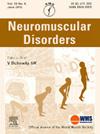Multi-omics approach identifies a novel recessive pathogenic variant in the TNNT3 gene in two siblings with congenital myopathy
IF 2.7
4区 医学
Q2 CLINICAL NEUROLOGY
引用次数: 0
Abstract
TNNT3 is the fast skeletal muscle troponin T compound of the troponin complex. Dominantly inherited pathogenic missense variants in TNNT3 cause distal arthrogryposis, whereas rare recessive TNNT3 variants are associated with congenital myopathy with distal arthrogryposis with and without nemaline rods. Here, we report two teenage sisters who presented at birth with hypotonia, proximal weakness, feeding difficulties and finger contractures. Muscle weakness was not progressive and clinical function improved over time. Muscle biopsies showed small atrophic fast fibres, internal nuclei, increased connective tissue and focal fat infiltration. Ultrastructural investigation revealed disorganised myofibrils and nemaline bodies in some fibres. Targeted sequencing of panel of genes causing congenital myopathy was negative. Trio whole exome and genome sequencing identified a novel homozygous intronic TNNT3 variant, c.67+128G>A. Sequencing of RNA derived from the patient’s muscle confirmed the variant’s detrimental effect on splicing. This work expands the allelic spectrum of TNNT3 related congenital myopathy and confirms the previously reported favourable disease course in some patients, although with an overall milder disease presentation in both siblings. It also highlights the utility of a combined multi-omics approach to diagnose previously unsolved cases of congenital myopathy.
多组学方法鉴定了两个患有先天性肌病的兄弟姐妹中TNNT3基因的一种新的隐性致病变异
TNNT3是肌钙蛋白复合物的快速骨骼肌肌钙蛋白T化合物。TNNT3的显性遗传致病性错义变异导致远端关节挛缩,而罕见的隐性TNNT3变异与先天性肌病伴远端关节挛缩,伴或不伴线状棒。在这里,我们报告了两个十几岁的姐妹,她们在出生时表现为张力低下,近端无力,进食困难和手指挛缩。肌无力无进展,临床功能随时间改善。肌肉活检显示萎缩的快纤维小,内核,结缔组织增多,局灶性脂肪浸润。超微结构检查显示部分纤维中肌原纤维紊乱,有线状体。导致先天性肌病的一组基因的靶向测序结果为阴性。三人全外显子组和基因组测序鉴定出一种新的纯合子内含子TNNT3变异,c.67+128G> a。从患者肌肉中提取的RNA测序证实了这种变异对剪接的有害影响。这项工作扩大了TNNT3相关先天性肌病的等位基因谱,并证实了先前报道的一些患者的有利病程,尽管两个兄弟姐妹的总体疾病表现较轻。它也强调了综合多组学方法诊断先天性肌病以前未解决的情况下的效用。
本文章由计算机程序翻译,如有差异,请以英文原文为准。
求助全文
约1分钟内获得全文
求助全文
来源期刊

Neuromuscular Disorders
医学-临床神经学
CiteScore
4.60
自引率
3.60%
发文量
543
审稿时长
53 days
期刊介绍:
This international, multidisciplinary journal covers all aspects of neuromuscular disorders in childhood and adult life (including the muscular dystrophies, spinal muscular atrophies, hereditary neuropathies, congenital myopathies, myasthenias, myotonic syndromes, metabolic myopathies and inflammatory myopathies).
The Editors welcome original articles from all areas of the field:
• Clinical aspects, such as new clinical entities, case studies of interest, treatment, management and rehabilitation (including biomechanics, orthotic design and surgery).
• Basic scientific studies of relevance to the clinical syndromes, including advances in the fields of molecular biology and genetics.
• Studies of animal models relevant to the human diseases.
The journal is aimed at a wide range of clinicians, pathologists, associated paramedical professionals and clinical and basic scientists with an interest in the study of neuromuscular disorders.
 求助内容:
求助内容: 应助结果提醒方式:
应助结果提醒方式:


